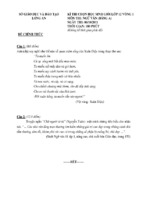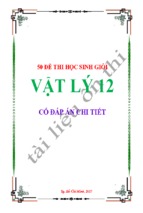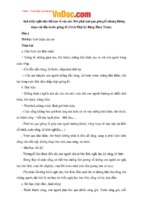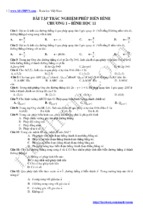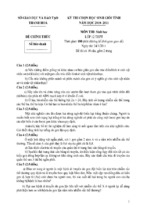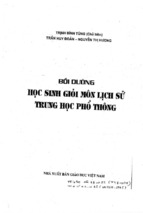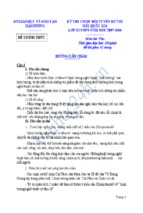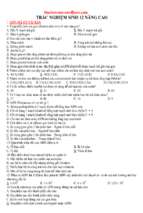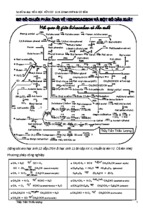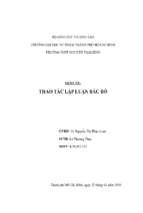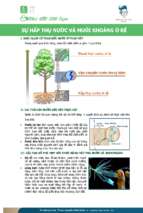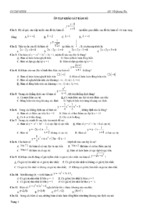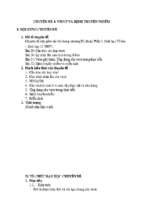đề thi học sinh giỏi quốc gia môn tiếng anh năm 2013
xY rur cHgN Hec s_tNH elOr
NAM 2A13
BQ GIAO DUC VA DAO TAO
oE rnr cnlr.rx rHr.fc
M6n
thi:
thi:
thi:
Thdi gian
Ngdy
t
c
ou6c cn rHpr
NENG ANH
180 ph0t (khOng fd tnOi gian giao dd)
s6 pnAcH
111s112013
oA tni cd 10 trang
Tttl sinh kh1ng dwqc s* dUng tdi ti'Qu, kO cd t* fr6n.
Gidm thi kh1ng gidi thlch gi th€m.
BANCIIINH
l. LISTENING (50 points)
HUONc pAt't pxAtr rHr NGHr nrEu
Bdj nghg sim 3 phdn, m6t pnan iluqc nghe 2 ldn, mfi tan cdch nhau I 5 gidy, mo dd,u vd k,t thtic
mdi phdn nghe cd tin hieu.
. Thi sinh c6 3 philt aA hoan chinh bdi nghe.
. Mpi hadng ddn cho thi sinh (biinS tiiing Anh) dd cd trong bdi nghe.
.
Paft 1: Forguesfion s 1-10, listen to a piece of news from BBC abaut Valentine's Day and suppty the
blanlrs with the missing informatian. Write NO MORE THAN THREE WORDS and/or A NUMBER taken
from the recording for each answer in the spaces provided.
Valentine's Day is not only a day for publ
it has also become a
when in the UK, more than 20 million pounds is spent on flowers and
over (3)
is used for chocolates in the United States. Despite its popularity,
the origin of Valentine's Day is still in the (4).
(2)
According to some historians, St Valentine was a Roman (5)
in the 3'd
century A.D. The imprisoned Duke of Orleans is believed to have sent the first Valentine card in the year
(6)
by writing love poems to his wife.
On Black Day in Korea,
(7)
the men
who don't receive anything on Valentine's Day gather to
and (8)
with each other.
With the development of technology, {9)
have become fashionable
recently. However, as warned by lnternet security experts, this may allow malicious hackers to spread
(10)
Part 2:
For quesfions 11-15, listen to a talk about bisdiversity and supply the blanks with the missing
infarmation. Write NO MORE THAN THREE WORDS taken from ffie recording for each answer in the
spaces provided.
11. Biodiversity is what enables humans to
12. Main cause of biodiversity erosion: destruction of
13. Example of ecosystem under threat:
14. lnvasion of non-native species can destroy native
15. Human population: has increased at a(n)
rate.
For quesfions 1F20, listen to a radio nelr/s report about minority languages and supply the blanks
with the missrng information. Write NO MORE THAN THREE tyORDS taken from the recording for
Page 1 of 10
16.
Welsh is a separate language, not an English
17. Cornish speakers are in a
18.
variation between different versions of cornish involves
19.
Modern Cornish borrows English words as it has many
2A. The rnost widely spoken version is called
Cornish.
Part 3: For questions 21*25, listen to a radio discussion on dictionaries and choose fhe besf answer
(4, B, C or D) according to what you hear. Write your ansu/ers in the corresponding numhered boxes.
21.
Elaine says she is under pressure at work as a result of
A. the growth of the market
B. the quality of the competition
C. the demand for greater profits
D. the need to manage resources
22.
Elaine decides to include a word in her dictionaries after checking
A. how it is used in the press
B. whether it is on the database
C. what her researchers think of it
D. whether its use is widespread
According to Elaine, in which area of her work has new technology had the greatest impact?
A. the accuracy of the entries
B. the speed of the research
C. the reliability of the data
D. the quality of the language
23.
_
24.
According to Tony, what may influence a dictionary compiler's decision to include a particular term?
A. technical experience
B. reading habits
C. personal interests
D, objective research
25.
According to Elaine, what prevents dictionary compilers from inventing words themselves?
A. respect for their colleagues
B. lack of inspiration
C. fear of criticism
D. pride in their work
Your arsu/ers
21.
22.
23.
24.
25.
Il. LEXIGO-GRAMMAR (30 points)
Paft 1: Cttoose the besf ansuver (A, B, C, or D)
anstl/efs in the corresponding numbered boxes.
to each af the foltowing guestions and write your
26,Attheendofthecompetition,alltherunnerSwere
27.
28.
29.
30.
31.
32.
33.
34.
35.
A. actually
B, wholly
C. utterly
D. eventually
I see no point
with such a perfect operating system.
A. doing
B. dealing
C. matching
D. tampering
There is
in the press that the Prime Minister will resign.
A. rumour
B. speculation
C. news
D. indication
The work is beyond a shadow of
one of the best she has ever written.
A. doubt
B. contradiction
C. cr"iticism
D. suspicion
The election will be held at the end of the week, at any
A. case
B. rate
C. situation
D. time
At first Tom insisted he was right, but then began to
A. back
B. follow
c. drop
D. break up
The ceremony was one hour late as the organisers
for such an adverse weather condition.
A. expected
B. bargained
C. calculated
D. supposed
I can accept criticism in general, but George
it too far, so I had no other option but to
show my disapprovat.
A.
B.
C.
D. rnade
Why do you object to him being taken on - he'll be
to the company?
A. property
B.
C.
D. material
The inconsiderate driver was
for parking his vehicle in the wrong place.
A.
B.
c.
D. confined
in
-
down
carried
inflicted
_.
off
hadn't
really
pushed
put
a(n)_
estate
asset
harassed
condemned
up
Page 2 of 10
Your answers
26.
27.
28.
29.
30.
31.
32.
33.
34.
35.
Part 2: Yllrlte the carrect FORM af each hracketed word
column on the rigttt. p) has been done as an example.
in the numbered space provided in the
FEARS OF FUTURE GLOBAL HUNGER
(0)_
A recent report has warned of global
(sHoRT) unless the
food
current system of farming and food distribution is changed. The report highlights
fears that curently rapid increases in yields come at the expense of sustaiiabitity,
and that unless action is taken, hunger and
become growing problems.
(36)-
(NUTRlEnl
0. _sho
fiages
36.
wirt
37.
Thereportalsoconsidersthebillionpeopleworldwidewho(37)
andarethereforeobesetobeanother(38)-(ExAMPLE)failureofthe
current system to provide health and
(39)
38.
{BE) to the world's population.
The authors believe that the application of new technologies can play a rote
in minimising future lacks of food, They see cloning, nanotechnoldgy and
39.
genetic(40)-(MoDlFY)aspotentialsolutions'
40.
However, although many of these technologies have been adopted worldwide,
(RESlsr) to their use in parts of Europe.
41.
there is still
(41)_
Part 3.' Ihe passage below contains 7 mistakes. IJNDERLTNE the mistakes and WRTTE THE/IR
CORRECT
FORITS in the space provided in the column an the right. (0) has been doneas afl example.
There is a long-standing debate am?ng users of .new media" and lnternet Service
Providers (lSPs) about so-called 'net neutrality" ithe idea that no-one should
control the lnternet). Both sides claim to uphold what they call "lnternet freedom",
but it appears they have diverging views of exactly which is meant by freedom in
this context.
0.
between
42.
43.
For supporters of neutral, lnternet freedom means equal, affordable access for
whatever online applications and content they choose. ln contrast, the lsps say a 44.
free lntemet means that the industry should be unimpeded by governmint
oversight and that high-speed connections should be available for anyone who 45.
can afford it.
The debate is overgrolvn with so many technical jargon that it hasn't attracted
widespreading attention, but what's at stake are nothing less tlran the future of the
lntemet. The issue, essentialiy, is whether financial corporations become
gatekeepers of online content and traffic, or whether small independent
organisations can access the new technology without restrictions. Whichever way
it goes, the outcome is likely to change the whole of popular culture.
46.
47.
48.
Part 4: Fill in the gaps in the fottowing senfences with suitabte paftictes. Write yaur ansu/ers
correspo nding numbered boxes. {0) has been done as an exampie.
(,.
He finds it hard to
put
49. The chairman brought
50. Evidence has borne
51.
52.
53.
fall
She decided to put He was too smart to
the
the noise of the nearby factory.
the matter of staff restructure in the tast meeting on the BoM.
the idea that language students learn best in small groups.
the conman.
a parttime job to supplement her meagre income.
The authorities declare they will come
the city.
in
_
hard
increasing mugging and burglary in
54. He has worked very hard to succeed in his career, I don't think luck comes
55. The boss was frustrated at the failure of the project and he took it
the chief accountant.
Page 3 of 10
Your answers
A. up with
49.
50.
51.
52.
53.
54.
55.
lll. READING (50 points)
Part 1: Read the following passage and decide which answer (A, B, C, or D) bestfits each gap.Write
your answer in corresponding numbered boxes. (0) has been done as an example.
LEGAL FIGHT HITS MUSIC PIRATES
Theglobalrecordingindustryhaslauncheditslargestwaveoflegal(0)-againstpeoplesuspected
of(56)-musicfilesonthelnternet.ThelatestmovebythelnternationalFederationofthe
(58)_
(57)--
peer-to-peer (P2P)
2,100 alleged uploaders
Phonographic lndustry (lFPl)
networks in 16 nations including the UK, France, Germany and ltaly. Thousands of people have agreed to
pay compensation since the campaign began. ln the US, civil lawsuits have been
against
more than 15,597 people since September 2003 and there have been 3,590 settlements. 'This is a
(59)_
significant(60)-ofourenforcementactionsagainstpeoplewhoareuploadinganddistributing
illegal music on P2P networks,' said lFPl chief John Kennedy. 'Thousands of people
-
mostly lnternet-savvy
menintheir20sor30s-havelearnttotheir(61)-thelegalandfinancialrisksinvolvedinfilesharing copyrighted music in large quantities.' lndividual cases are generally brought by the national
associations in the recording industry. The UK record industry has so far brought 97 cases, with a further 65
covered by the latest action.
0.
C. acting
C. using
C. directed
C. applying
B. activity
B. sharing
B. targeted
B. having
B. instigated
B. feature
B. charge
A. action
56. A. stealing
57. A. aimed
58. A. practising
59. A. canied
60. A. aftermath
61. A. cost
D. acts
D. downloading
D. pointed
D. using
D. activated
D. escalation
D. fortune
C. brought
C. result
C. benefit
Your answers
0.A
57.
56.
58.
tro
61.
60.
Part 2: For questions 62-70, read the text below and think of the ward which besf
only one word in each gap. Write your answer in corresponding numbered boxes.
as an example.
fits each gap. Use
p)
has been dona
NOT JUST MAKING A GOOD STORY
Mediainterestisgreaterinthosesituations(0)-acommunalorpersonaltraumaticeventfitsthe
working criteria of newsworthiness, with the
(62)_
that some events will attract wide media attention
while(63)-areoflittleinterest.Hencethoseeventswhich(64)-eliteorrepresentative
persons, unpredictable or unusual tragedy, loss or sorrow, and that epitomise universal themes or the failure
be of greater interest and attract greater media attention than recurring everyday
of technology
(65)_
traumassuchasdisea5eorcarfatalities.MostprintandelectronicjournaIistsare(66)-strong
pressure to report what has happened in such a way that it tells a good story and rnakes sense to readers
and viewers so that they not only know what has happened, but feel it as well. This is a pressure that derives
from forces
the control of individual journalists imposed by the media system and the
demands of the consumers of media products. The extent to
these expectations can be met
generally on a complex mix of the personal
within the practicalities of a trauma situation
stature and judgment of the journalist, the specific instructions of their managers and the practical situation in
which they
themselves"
(67)_
(69)
(68)
(70)
Your ansyvers
0. where
ot.
63.
64.
65.
66.
67.
68.
69.
70.
Page 4 of 10
Part 3: Far guesfions 71-75, choose the best phrase or sentence A-G (given betow the 761rt) b fiy
each of the blan*s in the following text. Write one letter (A-G) in corresponding numbered boxes.
Twa of the suggested answers do NOT fit at all.
CARS AND SOCIETY
Nowadays, just over half of all households in Britain have one or more cars. The increasing use of cars
has had an enormous effect on society, health, the landscape and other aspects of life, ln thg;lgth century
railway caused workers in other transport industries to lose their jobs, but they also employed a great many
people. ln the twentieth century, railway workers lost their jobs as roads provided more employment.
.
{71)-,
and have opened up whole areas which were formerly inaccessible. Country parks,
stately homes and other attractions often depend on access by car, for public transport rarely seryes inem.
{72):.
As late as the 1950s almost every district had a number of corner shops. People used
these shops for almost all the things they needed each day such as food, papers, and household goods,
They would have gone into towns to visit the market and purchase items unobtainable locally perhapl onf
once or twice a month. Daily shopping was done within the local community, and the meetings with other
people kept the community going.
(73)-,
traveling further than before and going by car if possible. The use of a car makes the
journey easy and means that they can bring back enough shopping to last them a week or more. Cars have
helped to drive many corner shops out of business.
(74)-,butmanytownsandcitieSnowhavegiantshopssellingdo-it.yoursetfmateriats,and
theseareoftenin.out-of.town,centresortradingestatesthatarenotservedbybus'(75)-.
Many other facilities also depend on improved road transport, often involving the use of cars. Modern
hospitals, schools, libraries and other institutions are often built to serve large areas. Cornpared with those
which they have replaced they are fewer, larger and more remote from the people who use them.
A. However, many railways have been improved
B. They depend on customers having cars
C. Modern town-dwellers like to have private transport
D. Nowadays, a large percentage of people do their shopping at superrnarkets
E, Nearly all shopping centres can be reached by bus as well as car
F. lncreased mobility, mainly by car, also leads to facilities closing
G. ln general, cars have increased people's chances of traveling for pleasure
Your answers
71.
Part
72.
73.
74.
75.
4: Read the following extract and answer questians 7f85.
POINTERS TO LEARNING
1,
A lecture may seem to be well organised in the lecturer's notes but have no apparent pattern when
delivered. ldeally students should be able to state the intended organisation, and how one fact is broadly
related to the rest, at any time during the lecture, firstly because they need to take notes if the amount of
information to be retained exceeds the amount they can rernember, and secondly because these links are
essential to understanding.
2.
lt follows, of course, that a lecture is likely to be n"lore effective if its organisation is given at the
beginning. This can usually be done very naturally as an explanation of how the lecturer's objectives are to
be achieved. Certainly the dictum "first tell 'em what you're going to tell 'em. Then tell 'em what you've told
'em', can usefully be applied to lectures and is particularly appropriate to those who teach a difficult subject
or who cannot easily get down to the students' level of understanding.
3.
Some lecturers may feel that by summarising all they intend to say at the beginning, they will have'shot
their bolt' and have nothing left with which to arouse interest when attention flags. ln this case the summary
1ee!s to. be given in a way that whets the appetite and the elaboration of points will require interesting
details, visual illustration, hurnour and an occasional anecdote
4.
ltemising points has several advantages. Firstly, each item provides a peg on which detail may be
hung. Secondly, while it may be obvious to the lecturer that he is going on to a flesh point this is not so
obvious to the listener, least of all the'student who is not already familiar with the topic. Thirdly, if a student
day-dreams, or has microsleeps, he may easily lose the thread of an argument. tf points are itemised he will
know when he misses one and he will be able to pick up the lecturer's drift again more easily, latching on to
Page 5 of 10
the point that follows. He may also be able to fill in the missing point with the help of another student later.
Just as most people are unaware that they dream 3 or 4 times each night so most students are probably
unaware how much their minds wander during lectures. Fourthly; itemisation is an aid to memory. Revision
from notes is more thorough if the students know "there are five points to be remembered on thii topic and
seven on the other."
5.
The organisation of a lecture will be clearer if the points are written on the board immediately after being
mentioned. Lecturers who are not confident of their ability on the blackboard are tempted to neglect it. One
way over this difficulty is to use an overhead projector which may show either normal handwriting done at the
t!me, or prepared acetate sheets which may be progressively displayed as the ;ecture develops.
Alternatively, a handout containing the main heading well spaced, with blanks in between for the students to
add supplementary detail, is useful; and since handouts may be passed on to absentees, they are
particularly valuable at the beginning of a course or at other times when it is important to convey the
organisation of subject matter. Such displays of lecture organisation (using the blackboard, overhead
projector, handouts, or possibly over methods such as flannel graphs and charts) play a particularly
important part in aiding comprehension when a flow diagram or other comptex forrn is used because the
relations between possibly abstract ideas can be pointed out visually.
ln brief, we can say information must be organised in the sfudenfs' mind and not just in the lecturer's.
For quesfions 7FgA, decide which of the nofes below {A-H) besf sums up each of the five
Paragraphs. Write yaur ansu/ers in the corresponding numbered boxes,
76. Paragraph 1
77. Paragraph 2
78. Paragraph 3
79. Paragraph 4
80. Paragraph 5
A.
Put it up on the blackboard
B. Ways of making key points clear
C. Maintaining interest
D. Clear structures important
E. Wandering minds
F. State structure at start
G. Why'key points' are useful
H. Filling in the detail
For questions 81-85, choose the answer which you think besf complefes th e u nfi nisfied sfatemenfs
about the fe,rt. lndicate the letter A, B, C or D against the number af each guesfion. Write your
answers in the correspanding numbered boxes.
81.Aclearideaofwhatalectureisallaboutisimportantbecause-.
A. students must always finish up with well-organised notes
B. it can capture students' interest
C. it can help the lecturer to present things more clearly
D. students must see how a topic hangs together if they are to understand
82.
Students are likely to take in a lecture better if the lecturer
A. gives them a summary before he begins
B. arranges what he has to say in the best possible way
C. improves his blackboard technique
D. gives out or displays comprehensive notes
83.
Some lecturers do not like giving an outline of their lectures at the start because
A. their notes are well-planned but they cannot make things clear to their students
B. they do not like repeating themselves
C. they are afraid that the rest of the lecture will seem like an anti-climax
D. they lack confidence in using the blackboard
84.
$tudents whose minds wander easily
A. rnay fail to make sense of points in a lecture
B. lose arguments because they cannot follow what is being said
C. have an ability to 'tune in' easily when their attention returns
D. seek help from other students to follow the lecture
85.
Lecturers can use an overhead projector
A. to present key points in advance
B. to present key points as they arise
C. to help students understand What a 'flow diagram' is
D. to show students normal handwriting done on the spot
Page 6 of 10
Your ansu/ers
76.
77.
78.
79.
80.
81,
82_
83.
84.
85.
Paft 5: Read the fallowing extract from a newspaper article about the environment. For quesfr'ons g&gl,
cfioose the best answer {A, B, C or D) according to the lrlrt. Write your answers in the corresponding
numbered boxes.
L9*borg's book entitled The Skeptical Environmentatisf caused an uproar when it was published in
1998. The author's beef is with the litany of doom espoused by certain environmental activists. We have all
heard the main points several times: natural resources are running out; the world's population is too big and
growing at an alarming rate; rivers, lakes, oceans and the atmosphere are getting Oirtiir all the time. Forests
are being destroyed, fish stscks are collapsing, 40,000 species a year are ficinglxtinction, and the planet is
warming disastrously. The world is falling apart and it is our fault.
Nonsense,
Lomborg. These are just scare stories put about by ideologues and promulgated by the
_says
media' There is little evidence that the world is in trouble, he claims, and a good deal more that s[ggests tnat
we have never had it so good. Air quality in the developed world has impioved markedly over thi-past 100
years. Human life expectancy has soared. The average inhabitant of the developing world consumes 3g%
more calories now than 100 years ago, and the percentage of people threatened with starvation has falten
from 35% to 18%. The hole in the ozone layer is more or less fixed; the global warming theory has been
much exaggerated, Aryl though we worry incessantly about pollution, the lifetime risk of drinking water laden
with pesticides at the European Union safe$ limit is equivalent of smoking 1.4 cigarettes. tn s[ort the world
is not falling apart; rather the doom mongers have led us all down the garden path.
'Lomborg' is the dirtiest word in environmental circles at the moment. Henning Sorenson, former
of the Royal Danish Academy of Science, maintains that his fellow countryman is wrong,
dangerous and lacking the professional training even to comprehend the data he presents. ihese are strong
words. Sorenson was referring specifically to Lomborg's opinions on mineral resources, but this book
contains sufficient biological nonsense to add ignorance of at least one more discipline to the charge sheet.
For example, long term growth in the number of species on Earth over the past 600m years itself a
president
disputed issue, though you would not know it - is accredited to 'a process of specialisation wiricn is both due
to the fact that the Earth's physical suroundings have become more diverse and a result of all other species
becoming more specialised,' One really has to look further than a United Nations Environment programme
report to understand such complex issues. And surely only a statistician could arrive at a figure -ot O.lot,
extinction of all species on Earth in the next 50 years, when respectable estimates of total diversity range
from 2m to 500m species {not 2m - 80m, as Lomborg claims)"
However, my greatest concern is with Lomborg's tone. He is clearly committed to rubbishing the views
of hand-picked environmentalists, frequently the very silly ones such as Ehrlich, whom professilnats have
been ignoring for decades. This selective approach does not inspire much confidence:- ridiculing idiots is
easy. Who better to manipulate data in support of a particular point of view than a professional statistician?
And who to trust with the task less than someone who argues like a lawyer?
The reader should be wary in particular of Lomborg's passion for global statistics: overarching averages
can obscure a lot of important detail. The area of land covered with trees may not have changed iruch in tne
past 50 years, but this mostlV because northern forests have increased in area while the biologically richer
!s
tropical ones have declined. lf you want to see how global trend translates into one particular 6cd context,
go to northem Scotland and gaze over the immense plantations of American conifers that have replaced
Britain's biologically unique native peatlands. And to balance the books, the area of these noisorJre tree
farms has to be reflected by deforestation somewhere else in the world, let's say Madagascar, for example.
That the global forest area has remained more or less constant actually tells us nothing about the state of the
environment.
So have we been led down the garden path by the environmentalists? Lomborg argues a convincing
case with which I have much syrnpathy, but the reader should perhaps follow the authbr's lead and maintain
a healthy scepticism. And if you come away with the nagging suspicion that Lornborg has a secret drawer of
data that does not fit his convictions, then you are quite probably a cynic.
86.
_.
Lomborg believes that
A. environmental pessimists have misrepresented the facts
B. not enough is being done to curb the world's population explosion
C. we are abdicating our responsibility in caring for the planet
D. the dirnensions of the global warming problem have been underestimated
Page 7 at
1A
87. what evidence does Lomborg provide to support his point of view?
A. The media have helped to spread panic.
B. Cigarette smoking does not pose a lifetime risk.
C. Overeating is becoming considerably more common.
D. Peopte tend to live longer than in the past.
88.
89.
Lomborg is unpopular in the environmental world because
A. he is not capable of understanding the complexities of environmental research
B. he makes use of unsupported craims to propose new theories
c, he simplifies existing data to support his own spurious claims
D. as a statistician he doesn't have the necessary background to attack existing flndings
What do Lomborg and the writer have in common?
A. A mistrust of lawyers
B. A conternpt for some environmentalists
C. A selective approach to global problems
D. An admiration for statisticians
_.
90. why does the writer mention
scoiland and Madagascar?
A. As an example of deforestation
B, As evidence that available data on forests is insufficient
C. To show that global statistics can be misleading
D. To show how natural vegetation is being threatened by imported trees
For guestions g1-95, write
in the correspo nding numbered boxes
sfafement agrees wittt the writer
if the statement contradicts the writer
ArG if it is impossib le to say what the writer thinks about this
91. when published, Lomborg's book came in for a lot of criticism.
Y
,t,
92.
93.
94.
il
the
Lomborg sees eye to eye with the doom mongers on the idea that the world is falling apart as a result of
man's fault.
Lomborg and sorenson work for the same institution.
The fluctuation of the area of land covered with trees can reveal much about the worsening environmentat
deterioration.
95. on the whole, the writer remains
skeptical about Lomborg's book.
Yaur ansrryers
86.
87.
88.
89.
90.
91.
92.
93.
94.
95.
lV. WRITING (50 points)
Part 'l: Use the word given
in brackefs and make any necessa/:y additions to write a neyy sentence in
sucfi a way that it is as similar as possib le in meaning to the originat senfence . Do NOT chanse the
fpfm-of the siYen wors!. You musf use between tfrIee ahd eiqht words, inctudin@
fias been done as an example.
0. He paid no attention to our waming. (notice)
He _took
no notice of.
our warnrng.
96.
Suzanne did better than usual at her final oral exam, although she had a sore
Despite
throat.
her final oral exam.
97.
Twenty singers are competing for the tifle 'singer of rhe year'.
98.
There
Tom is far better than me in terms of language skills.
99.
When it comes
I know you'll find it hard to believe, but I've never travelled
(contention)
the title'Singer of The Year'.
(match)
for Tom.
abroad.
(seem)
Unlikely
l've never travelled abroad.
100. You ean attend as many classes as you want as long a$ you can manage your
time.
There
(excelled)
(restrictions)
you aftend as long as you can manage yourtime.
Page 8 of 10
Part 2: The charts below show the profit made by MG Entertainment (a record company) from
different formats i n th ree Eu ropean cou ntri e s.
Summarlse the information by selecting and reporting the main features, and make comparisons
where relevant. Write at least 150 words.
1
997
50
45
40
O?Er,r,
o
!30
o
c25
320
'E
l5
10
5
0
fkr"
2007
50
45
40
835
o
=30
c25
gzo
'E ls
{0
5
0
r,**o ^""c'
iEf
tt"S'
{$'+'
Page 9 of 10
of about 350 words to express your opinion on the fotlowing topic:
"Modern technology has increased our material wealth, but not our happiness."
Part 3: ltUrite an essay
(You may continue your writing on the back page if you need rnore space)
fl
nl
* THE EI{D Page 10 of 10
- Xem thêm -


